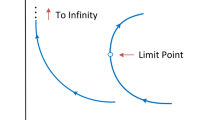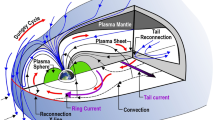Abstract
The Moon-to-Earth low energy trajectories of ‘detour’ type are found and studied within the frame of the Moon-Earth-Sun-particle system. These trajectories use a passive flight to the Earth from an initial elliptic selenocentric orbit with a high aposelenium. The Earth perturbation increases the particle selenocentric energy from a negative value first to zero and then to a positive one and therefore leads to a passive escape of the particle motion from the Moon attraction near the translunar libration pointL 2. This results in the particle flight to a distance of about 1.5 million km from the Earth where the Sun gravitation decreases the particle orbit perigee distance to a small value that leads to the particle approaching the Earth vicinity in about 100 days of the flight. A set of the Moon-to-Earth ‘detour’ trajectories is defined numerically. Characteristics of these trajectories are presented. The ‘detour’ trajectories give essential economy of energy (about 150 m/s in Delta V) relative to the usual ones.
Similar content being viewed by others
References
Belbruno E A and Miller J K 1993 Sun-Perturbed Earth- to-Moon Transfer with Ballistic Capture;J. Guidance, Control and Dynamics 16(4) 770–775.
Belló Mora M, Graziani Fet al 2000A Systematic Analy- sis On Week Stability Boundary Transfers To The Moon; Presented at the 51st International Astronautical Congress, held in Rio de Janeiro, Brazil, October 2000. Paper IAF-00-A.6.03, p. 12
Biesbroek R and Janin G 2000 Ways to the Moon?;ESA Bulletin 103 92–99.
Egorov V A and Gusev L I 1980Dynamics of the Earth-to- Moon Space flights (Moscow, USSR: Nauka Publishers) 543 pp.
Gatland K 1982The Illustrated Encyclopedia of Space Tech- nology (London: Salamander Book Ltd.) 296 pp.
Hiroshi Yamakawa, Jun’ichiro Kawaguchi, Nobuaki Ishii, Hiroki Matsuo 1993On Earth-Moon Transfer Trajectory with Gravitational Capture; Presented at AAS/AIAA Astrodynamics Specialist Conference, Victoria, USA. Paper AAS 93-633, p. 20.
Ivashkin V V 2002 On Trajectories of the Earth-Moon Flight of a Particle with its Temporary Capture by the Moon;Doklady Physics, Mechanics 47(11) 825–827.
Ivashkin V V 2003On the Earth-to-Moon Trajectories with Temporary Capture of a Particle by the Moon; Presented at the 54th International Astronautical Congress, held in Bremen, Germany, September 29–October 3, 2003. Paper IAC-03-A.P.01, pp. 1–9.
Ivashkin V V 2004aOn Trajectories for the Earth-to-Moon Flight with Capture by the Moon; Proceedings of the International Lunar Conference 2003 (eds) Steve M Durstet al, American Astronautical Society AAS. Vol. 108, Science and Technology Series, Paper AAS 03-723, pp. 157–166.
Ivashkin V V 2004b On Particle’s Trajectories of Moon-to- Earth Space Flights with the Gravitational Escape from the Lunar Attraction;Doklady Physics, Mechanics 49(9) 539–542.
Ivashkin V V 2004cOn the Moon-to-Earth Trajectories with Gravitational Escape from the Moon Attraction: Presented at the 18th International Symposium of Space Flight Dynamics, held in Munich, Germany, 11–16 October, 2004. Paper P0111, http://www.issfd.dlr.de/papers/P0111. pdf.
Koon W S, Lo M W, Marsden J Eet al 2001 Low Energy Transfer to the Moon;Celestial Mechanics and Dynami- cal Astronomy (Netherlands: Kluwer Academic Publish- ers)81 63–73.
Lidov M L 1961 Evolution of the Planets Artificial Satellites Orbits under Effect of the Outer Bodies Gravity Pertur- bations;Artificial Satellites of the Earth (Moscow, USSR: Nauka Publishers)8 5–45.
Lidov M L 1962 The Evolution of Orbits of Artificial Satellites of Planets under the Action of Gravitational Perturbations of External Bodies;Planet. Space Sci. 9 719–759.
Stepan’yants V A and L’vov D V 2000 Effective Algorithm for the Motion Differential Equations System Solving;Mathematical Modeling (Moscow, Russia),12(6) 9–14.
Sternfeld A 1934 Sur les trajectories permettant d’un corps attractit central á partir d’une orbite keplérienne donnée;Comptes rendus de l’Acad. des Sciences (Paris, France)198 711–713.
Sternfeld A 1937Introduction to Cosmonautics (Moscow, USSR: ONTI NKTP Publishers), 318 pp; 1974 2nd edn (Moscow, USSR: Nauka Publishers), 240 pp.
Sternfeld A 1956Artificial Satellites of the Earth (Moscow, USSR: GITTL Publishers), 180 pp; 1958 2nd edn,Arti-ficial Satellites (Moscow, USSR: GosTekhIzdat Publish- ers), 296 pp.
Author information
Authors and Affiliations
Rights and permissions
About this article
Cite this article
Ivashkin, V.V. Low energy trajectories for the Moon-to-Earth space flight. J Earth Syst Sci 114, 613–618 (2005). https://doi.org/10.1007/BF02715945
Issue Date:
DOI: https://doi.org/10.1007/BF02715945




